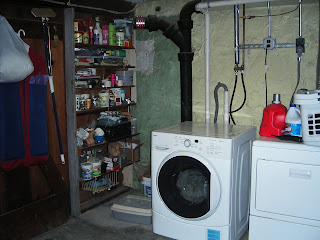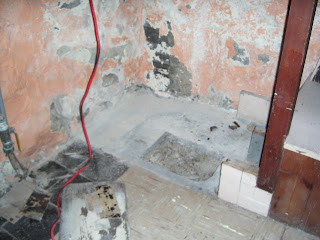Field stone foundations are notoriously constructed bad - not just are they constructed bad, they are a bad construction choice as no thought was ever given as to how water was going to react with them. The way mine was constructed in the 1940s was with average 8-10 in. stones mortared together on the inside and outside faces and nearly dry-layed in the middle with some parts mortared. The inside face has been parged (this is a layer of mortar, in my case, anywhere between 0-1" thick). The outside joints are in constant contact with the soil and water and eventually degrade, deteriorate and disappear. The water and soil then can freely enter the foundation and start working at the interior joints and eventually water will be seen seeping through the inside of the foundation. The parge layer is the last barrier against water but as you can imagine, once water can get inside the foundation wall, it's a downhill battle from there no matter how much the inside parging is on the foundation wall.
For me, I wanted to repoint the exterior joints of the foundation, waterproof the outside joints, place a layer of drainage stone against the foundation on the outside, a filter fabric then backfill the soil. In New Englancd we typically have full basements; our basement foundation wall height from the concrete slab to the underside of the joists is about 7 feet. The outside of the foundation is exposed above ground anywhere from 2 inches to 12 inches around the house, which means the foundation wall on the soil side is about 6'10" to 6'0" below the ground.
Our house is a standard size footprint to other houses in our area of 24 feet by 28 feet. I decided to start with the side on the right shown below - a 24 foot length of the house which gets the most water coming in during large rain events - that side of the house is the low point for draining water from the adjacent property. It also happens to have a 6 foot high retaining wall 7 feet from the house foundation that I had to make sure wasn't undermined during excavation. I kept my excavated soil braced during excavation - soil is very heavy (about 130 pcf - pounds per cubic foot) - if it lands on you, there's a good chance it's a life changing event. In addition, if the soil moves into the excavation, it will affect the retaining wall in a bad way. The retaining wall is already leaning in about 6 inches, so I didn't want to make that worse.


Having said all that, this more difficult side is where I wanted to start. There is a window in the small ditch shown where a window exists. The window was filled with stone because it was more in the way in this location than useful.
I made a 3-4 foot wide trench for the 1st 3 feet down then stepped it to a 2 foot wide trench for the remaining 3 feet to the bottom of the foundation wall. I did know that the bottom of the foundation was not much further from the top of the slab in the basement, so I just stopped there - that kept most of the foundation wall dry and directed water to the inside perimeter drain that was previously installed.
I braced the soil back. It was tedious because I had to work around irrigation pipes, a gas line and an electrical line. I had a neighbor's high school aged
son help me for a while, but that was inconsistent; most of the work was done by me.
Before the wall were backfilled, the foundation was waterproofed with UMACO U-Seal, with an admixture, a cementitious material that is applied to the outside of the stone.
Finally, the drainage layer and backfill were placed at the same time against one another a few inches at a time. The drainage stone actually was sifted out of the excavated material with the remaining soil placed farthest from the foundation. Finally, about 6 inches below grade, a rubber membrane was placed so any surface water would drain away from the foundation.
Work progressed at the front of the house in the same manner
with the exception of 2 window wells that were constructed. Here you can see the foundations for the window well with a pipe placed inside the well to drain to the drainage layer that will be placed outside the window well.
The window well walls were built up...
A concrete slab with the final drain position was placed inside the window well...
Stones were chosen from the excavation and layed as tile within the window wells as the finished layer. The stones were set in a tinted mortar to resemble sand.
The work actually began at the end of 2006 and was completed at the end of 2007. All the drainage stone was sifted out of the excavated material - there was no material brought in - I did have to remove about 2 cubic yards of the sifted dirt - I tried to place what I could in the garden but there was just too much. There is about a 1 foot layer of drainage stone on the outside of the foundation as well as outside the window wells.
I completed 24 feet on the side of the house and 20 feet in front of the house. I still have an 8 foot section in front to do where the front steps are, but I'll do that work when the front steps are done (they need to be repaired or replaced) - this section doesn't have any problems with water coming in the foundation walls. The rear of the house has another 12 foot section that needs to be done - this section does have problems with water seeping through the walls, so I'll have to get to it at some point (not this year...).
July 14, 2009










































